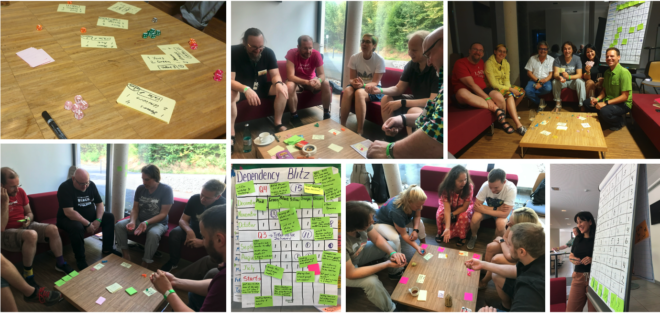Drowning in Dependencies? Try a new Dependency Game! – TastyCupcakes.org
Authors:
Dana Pylayeva, Ilja Vishnevski
Goal of the video game:
Discover a golden course to providing optimum company worth by taking advantage of partnership vs. getting stuck in reliances.
Variety of gamers: 4– 6 gamers
Period: 6- 12 rounds (60– 90 minutes)
Video game aspects:
30 dice (6 various colours, 5 dice each)
1 facilitator die
36 difficulty cards (6 per each colour)
12 benefit cards
1 Shipment board
Download and print the Obstacle cards, benefit cards and the Shipment board.
Video game setup:
- If there are less than 6 gamers in the video game, eliminate additional colours (dice and matching colour difficulty cards)
- Disperse the dice to the gamers, one colour per gamer.
- Location difficulty decks on the table, deal with down and benefit card deck deal with up.
Round one:
- Set: Facilitator rolls the die to expose the variety of reliances that the gamers will require to deal with in the preliminary. Gamers open a matching variety of the difficulty cards, and put them on the table face up.
- Strategy: Gamers choose whether they will be working separately, team up on resolving reliances or divide their capability, and effort to do both.
- Run: Everybody chances at the exact same time according to the strategy.
- Determine
- Private work: Gamer gets 1 company worth point for rolling “1” on any of his/her dice that were assigned for this work.
- Obstacle card: Group gets an amount ( 5 or 8 company worth points) of the difficulty card that they had the ability to resolve in this round.
- Shipment board gets upgraded with the outcomes and the gamers continue with the next round.
Note:
- Partly done cards do not make worth and they “secure” the partly done dice till dependence is totally fixed.
- Obstacle cards can have time boxes (1 month, 3 months). If this card’s dependence is not fixed by the time box, the group starts to spend for the expense of hold-up (unfavorable worth of the card) in each round, till fixed.
- Obstacle cards can represent technical reliances (suggested by a capital T in a circle). When this dependence is fixed, the gamers have an option: to count the worth towards the overall shipment OR to exchange it for among the benefit cards.
Next rounds:
- Set: If there are existing reliances left on the table from a previous round, when a facilitator rolls the die, brand-new reliances are included just if the number on the die is higher than the variety of pre-existing reliances.
- Strategy: Gamers make intend on their capability allowance, understanding that some for their dice may be “secured” in a partly done work from the previous round.
- Run: Gamers chance according to the strategy
- Determine: Business worth points are determined (changed for the expense of hold-up) and taped in the present month column on the Shipment Board
Note:
- If this round represents completion of March, June or September on Shipment Board, overall worth provided is determined for the quarter, and the group is welcomed to run a quarterly retro and preparation. At this time they might pick to drop any reliances that they have not begun by “paying” 1/2 of the card worth, or drop any partly begun reliances by “paying” amount of the card.
- If this is the last round( December on the Shipment Board), the overall worth provided is determined for the whole year. When overall worth is determined, the overall stated value of any insufficient or partly total reliances are subtracted from the overall company worth provided by the group in the previous 12 months.
Video game debrief concepts:
- What did you see in our method of working? Our interaction?
- How is this linked to your reality dependence difficulties?
- How did it feel to work under time box pressure?
- What insights have emerged for you throughout this video game?
Recognition:
This video game became a concept throughout a video game style pre-event assisted in by Tim Yevgrashyn & & Katrin Elster at the Play4Agile 2022 conference. From a concept to a playable model, the video game progressed through quick prototyping, everyday (and night) play screening with the aid, concepts, feedback and cheers from the group of wonderful nimble video game designers, who I am influenced by and really grateful to (in alphabetical order):
Marc Bless, Olaf Bublitz, Kurt Cotoaga, Martin Heider, Reinald Kirchner, Falk Kühnel, Michael Mahlberg, Christian Methfessel, Nastassia Krupiankova, Stanislava Potupchik, Markus Reinhold, Anja Steidl, Lucian Adrian Stroie, Adrian Suciu, Malte Sussdorff, Michael Tarnowski, Andreas Thier, Ilja Vishnevski, Silvana Wasitova, Tim Yevgrashyn.

What’s next?
If you like to get informed when an expertly printed Dependence Video game is offered on The Gamecrafter, include your name to this newsletter.
If you enjoy to run it with your groups in a DYI variation, print the files, play and send me your feedback!
Dana Pylayeva is a worldwide speaker, author and a nimble video games designer, developer of “DevOps with Lego and Chocolate”, “Worry in the Work environment”, “Security in the Work environment” and “Dependence Video game”.
Dana is an ICF Credentialed Specialist Qualified Coach (PCC), Scrum Alliance Qualified Business Coach( CEC), and Training from the Back of the Space Qualified Fitness Instructor (TBR-CT).
She is enthusiastic about letting loose management capacity in people and groups. She brings an effective combination of several training designs (Co-Active, Favorable Intelligence, Executive Training), assistance with Liberating Structures, deep understanding of Agile and DevOps area in addition to a breadth of experience dealing with remote groups and global customers (United States, Canada, UK, Ireland, Japan, India and so on).
Source link

